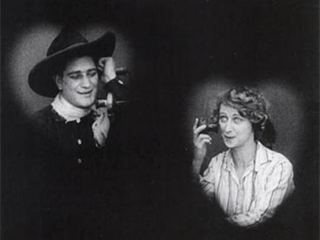
When Blinky, with the rest of the boys of the Lazy L., burst into town after two months on the roundup, and only to learn that prohibition has swept that part of the country, their indignation knows no bounds. Lining up at a soda fountain, they endeavor to quench their thirst. Margaret, daughter of Selby Maynard, a rancher, is the day operator at the telephone office. Jim Pittman, better known as 'The Killer,' has long been her suitor, but she has repeatedly rejected his offers of marriage. On this day Jim comes to the telephone office and threateningly proposes to her again. Alarmed, Margaret manages to put in a call to the confectionary store, where the proprietor overhears the conversation at the telephone office, and realizes Margaret's danger. He informs Blinky and the boys, who rush to the rescue. Jim is ousted, and Blinky remains at the office on guard. As the months go by Blinky gets into the habit of telephoning to Margaret on every possible occasion, with the boys generally listening to his conversation from ambush. Jim endeavors to persuade Maynard to force Margaret to marry him, and after giving him a severe beating, Maynard drags him from his ranch to the road. A little later Jim's ungovernable temper gets him into serious difficulty. A shot that he sends after a fleeing Chinaman strikes a small girl in the arm. An indignation meeting is the result and it is resolved to hand Jim Pitman a lesson. Jim hears of this, and his yellow streak asserts itself. He is captured by a deputy sheriff and led off to jail. But fearing the vengeance of the mob, he pleads to be taken to the county jail for safe keeping. To this the deputy finally agrees, and handcuffing one of Jim's wrists to his, the deputy leads him toward the station. But en routs, Jim manages to strike the deputy, knocking him unconscious. He is unable, however, to find the keys of the handcuffs, and is forced to drag the senseless deputy after him. A few hours later, chatting with her father over the phone, Margaret becomes alarmed when she hears a shot, and is then able to get into conversation with her father. The other operator happening in, Margaret persuades her to take her place at the switchboard while she rides out to see what has happened. Jim, who has started out on a wild career of revenge, and with the deputy still dragging after him, sees Margaret riding home, and she falls from her horse at a railroad crossing. Coming in from fence riding, Blinky calls up, and from the operator learns of the happenings. He fears that Jim may be waiting for Margaret, and with the rest of the boys, sets out for her home with a fast passenger train bearing down on her. Margaret is rescued in the nick of time by Blinky, he jumping from his horse and dragging her from the tracks as the train whisses by. Her wounds are found to be not serious, and her father, who appears on the scene, has only a broken arm as the result of a mad man's vengeance. Jim, having finally freed himself from the deputy, stumbles into a forgotten wolf trap, and with horror, realizes what his fate will be unless he is found. - The Moving Picture World May 13, 1916: p. 1218-1219
Released by the Mustang brand on May 5, 1916, With a Life at Stake is a contemporary western drama that depicts the tribulations of the cowpunchers in a border town when the prohibition wave hits it. Directed by William Bertram, the story revolves around the villain, Jim Pittman, who threateningly proposes to Margaret, the daughter of a rancher. Margret calls to ask for help and the protagonist, Blinky, rescues her from the villain Jim Pittman. Later, Margret and Blinky get into the habit of telephoning each other occasionally. Unlike the typical story in which the hero defeats the villain, Pittman’s evil acts eventually make him fall into a wolf trap. One of the most memorable scenes throughout the film is the telephone scene that features a splint-screen editing technique between Margret and Blinky. “The scene is followed by a matte shot with the two lovebirds framed in heart-shaped masks in an otherwise black frame,” the placement of the two characters’ images makes it seem like they are having eye contact and talking right next to each other. Established by 1913, “split structure could be appropriated for narrative purposes, which implies creating suspense via degrees of knowledge and spatial hierarchies.” It is more than simply displaying the conversation between characters, but their facial expression, along with the heart-shaped images, tells the romantic relationship between the two. The film came as a nitrate print sometime around 1960 and is currently stored by George Eastman Museum. A 35mm safety negative was created from that nitrate and two safety prints, one 16mm and one 35mm, sometime before or around 1974/1975. - Sherry Fan , FAMST 151FA _________________ Works Cited 1. Fullerton, J., & Olsson, J. (2004). Allegories of communication: Intermedial concerns from cinema to the digital. John Libbey. 2. George Eastman MUSEUM. (2021, September 10). Retrieved September 9, 2021, from https://www.eastman.org/. 3. The Moving Picture World, May 6, 1916, pp. 948